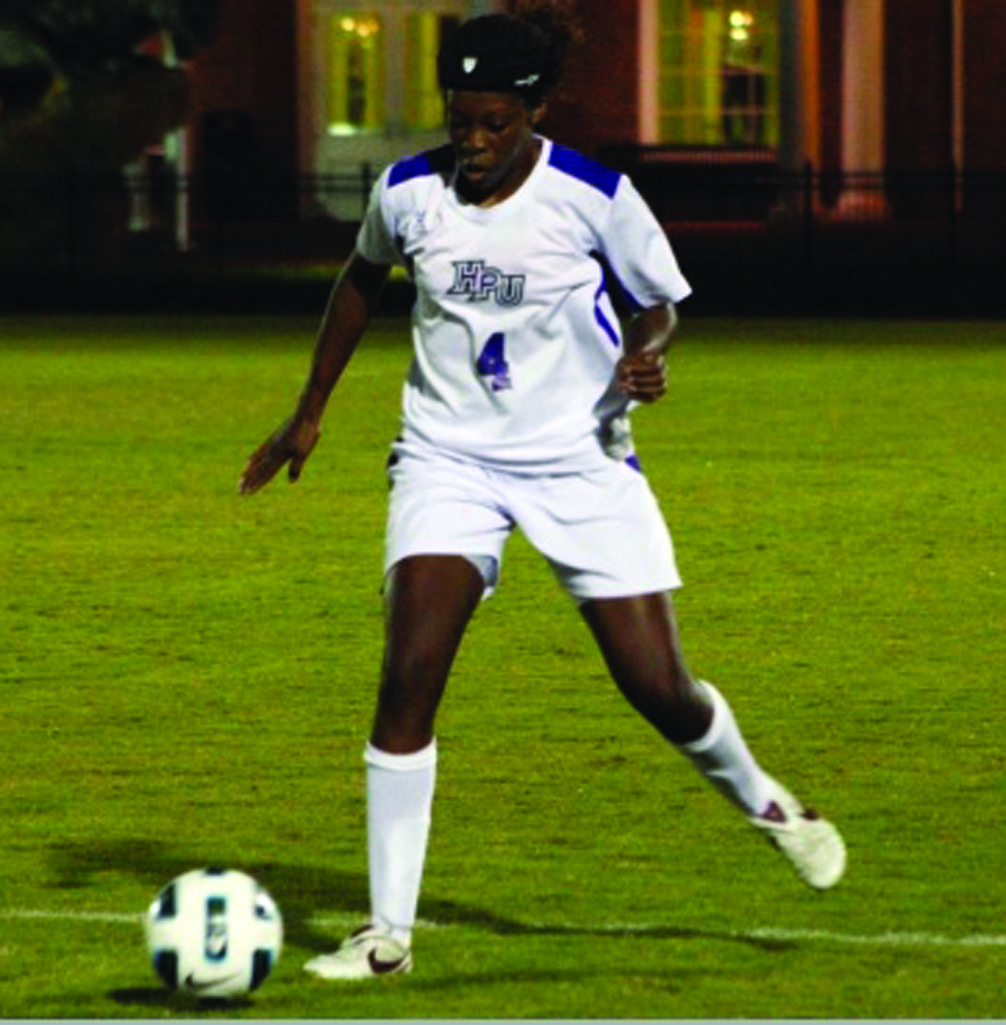The regimented lives of NCAA student athletes

HPU Women’s Soccer Player Janay Whittaker.
By Steven Haller
When students make a choice to participate in an NCAA Division 1 program, they make quite a heavy commitment. From the outside looking in, others are relatively unaware to the actual number of responsibilities college athletes must complete.
Student athletes have weeks that are way more crammed than those of non-athletes. All college students have to attend class and complete all of their school work. During an average day, they may also get to socialize with friends, watch television, or take a nap if they did not get enough sleep the night before. Division 1 athletes do not have those luxuries.
“The number one thing for student athletes no matter where they are going to school is time management,” said Erika Carrubba, Assistant Sports Information Director at High Point University.
“If you are not a good manager of your time, you are going to struggle because there are so many responsibilities put on you.”
Student athletes have to attend class and do all of their school work just like all students. But they also have to go to practice, work out in the weight room, meet with the athletic trainers, attend interviews for the media, go to film shoots for half time and pregame sports videos, attend required study hall hours, meet with professors to discuss a class they know they will miss for a game, participate in the actual games, and travel to and from games.
Janay Whittaker, junior defender on the HPU women’s soccer team, said, “Some days during the season we have a 6 a.m. practice that is about an hour and a half long, and go to class after that. That same day we would have a weight room session. Other days we have night practice from 8 p.m. to 10 p.m. Then we have to find time for homework and study hall between all of that, all the while trying to eat properly and get eight hours of sleep every night.”
Traveling is also time-consuming for NCAA programs. Whittaker said that most of her team’s games are at 7 p.m. For a three-hour trip, the team would leave at 2 p.m. to get there and still have time to relax and be ready by the time warm-ups start. Then, the game is about two hours and the team has to drive three hours back to arrive at HPU by midnight; that is 10 hours.
Nick Schumacher, senior pitcher for HPU baseball, said, “With the regular schedule that comes with being a student athlete, it is almost like a job.”
The HPU baseball program requires players to arrive to games three hours before the first pitch. Schumacher arrives at games another hour before that for individual preparation. The team played 56 games last season, so that is 56 extra hours out of his time during the regular season.
But it is not just during their season when student athletes are busy. They often have to sacrifice some or all of usual breaks that non-athlete students get, such as spring break and Thanksgiving break. Some athletes do not get the luxury of seeing their family on Thanksgiving.
The schedule is the most difficult part of student athletes’ lives, but they also have to ensure they are following NCAA rules.
The NCAA currently restricts student athletes to 20 hours of work with coaches. This serves as a way to protect the student athletes from exhaustion.
“When I played baseball, we would have to block out noon until 6 p.m. every day, so we would have six-hour days and then we would do our rehab and so forth afterward,” said Craig Keilitz, Athletic Director at HPU and former college athlete as a baseball player at Central Michigan University. “I think we have made some good decisions in college athletics to make the 20-hour limit and not totally dominate the lives of our student athletes.”
NCAA rules also make student athletes worry about what they eat and drink. According to the NCAA banned drug list, student athletes may not take any form of stimulants, which includes drinking energy drinks or anything with caffeine. Think of how many times students look to caffeine in order to complete a project or stay up to study.
Student athletes are regularly tested for using caffeine. They can be penalized if caffeine concentrations in urine exceed 15 micrograms per milliliter. This could occur from ingesting any products that use caffeine as a primary ingredient, such as coffee, sodas, energy drinks, or pills that treat headaches.
There is so much for student athletes to do, and Keilitz says, “Until you live it, you really cannot comprehend the difficulty.”
It is difficult to successfully live that kind of life, but student athletes at HPU are doing it very well. The current average GPA of student athletes at HPU is 3.1, well above the NCAA’s rule that every athlete must have above a 2.0 GPA.
The degree of difficulty also goes up due to the age of the student athletes that are accomplishing all of this. When fans watch Duke basketball games or Alabama football games, athletes are often viewed as adult professionals. It is important to remember they are not.
“With so much media coverage, it is often forgotten that the athletes you see on television competing are kids, 18- to 22-year-old boys and girls,” said Carrubba. “Playing sports is not their job; they are not professionals. They are here to get an education first and then play sports.”

